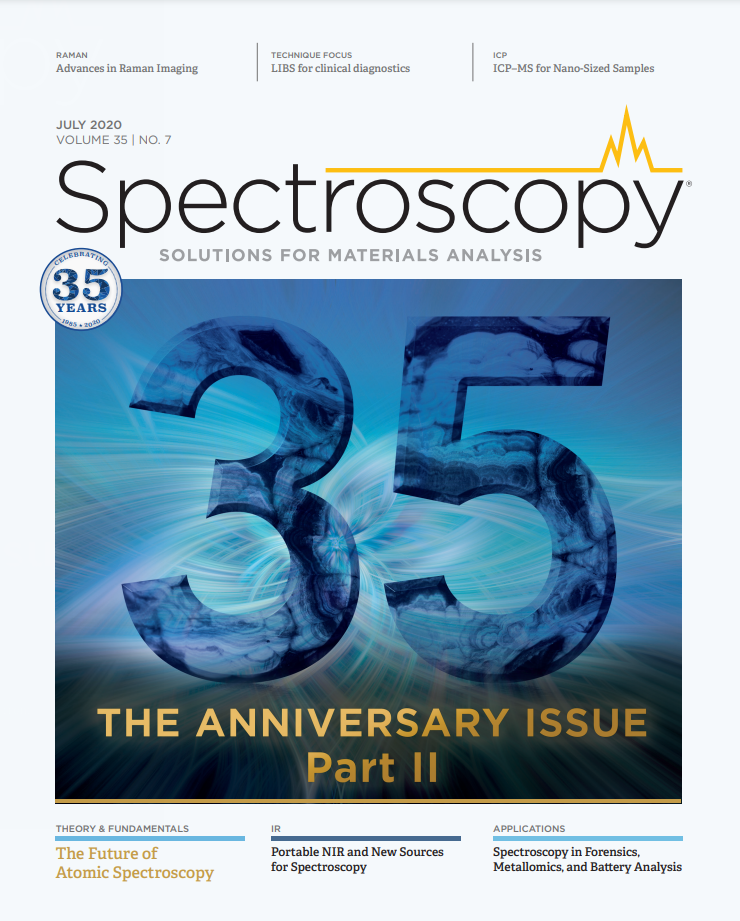Combining Spectroscopy with Microscopy for Advancing the Analysis of Forensically Relevant Traces
Spectroscopy
Forensic traces are physical remnants of past events that provide critical information for criminal and civil investigations and adjudications. The scientific examination of traces is an incredibly valuable tool for forensic investigations, because the skilled interpretation of traces yields factual answers to a range of pertinent questions.
Forensic traces are physical remnants of past events that provide critical information for criminal and civil investigations and adjudications. The scientific examination of traces is an incredibly valuable tool for forensic investigations, because the skilled interpretation of traces yields factual answers to a range of pertinent questions. Not only are traces able to associate a person with an incident, thus answering the “who” question, but they may also be used to answer “what”, “where,” “when,” “why,” and “how” (1). The most significant factor limiting the value of traces for scientific investigations was eloquently captured by Paul Kirk (1953) when he wrote, “Only human failure to find it, study, and understand it, can diminish its value” (2).
The Power of Microspectroscopy
The combination of microscopy and spectroscopy, or microspectroscopy, is a powerful tool for the study of traces and enables their understanding and interpretation. Microspectroscopy has a plethora of advantages, most notably providing rapid and often non-destructive (or minimally destructive) analysis of a range of specimens, sometimes with little to no sample preparation, and creating a reviewable record of the examination (3). The chemical identification of traces via microspectroscopy may enable a criminalist to determine provenance, and, depending on the sample, individualize it (that is, successive reductions to a class of one, or the establishment of two items having a common source) (2–4). Microspectroscopy is not just for small samples. Although most people think of traces as being microscopic, this is not necessarily the case. Traces may be large objects, such as car headlights or baseball bats, that are left behind or removed from the scene after an incident. Microspectroscopy provides chemical information on the microscale that is useful for the study of small traces that require magnification (such as single fibers or gunshot residues), and large traces or mixtures where imaging is important for examining its physical or chemical components (such as for microhomogeneity or heterogeneity analyses).
Forensic scientists use a range of microspectroscopical methods for the evaluation of traces, sometimes being at the forefront of their applications, while other times being more cautious with their implementation in casework. The first pairing of microscopy and spectroscopy was by Henry Clifton Sorby in 1868, who recorded the visible light spectra of natural biological pigments as well as blood, the latter having forensic implications (3). It was not until the 1950s that laboratories further developed visible light microspectrometers, which eventually led to their commercial availability. In the 1970s, its utility for the forensic analysis of traces, specifically for fiber evidence, was fully realized (3). Today, ultraviolet-visible (UV-vis) microspectroscopy is employed to study a range of traces, most commonly fibers, paint, and inks. Molecular microspectroscopy-infrared (IR) and Raman-is widely used in forensic science to detect and identify a variety of specimens, including, but not limited to, fibers, paint, polymers, drugs, soil minerals, cosmetic evidence, and general unknowns. IR microspectroscopy was first developed in the late 1940s and early 1950s, but did not see widespread adoption until the 1970s with the affordable availability of Fourier-transform computing capabilities (2). IR microspectroscopy was recognized at that time by some forensic scientists, notably microscopists at Walter C. McCrone Associates, Inc., to have value for the identification and discrimination of traces, and it was implemented for case examinations and research as soon as this technology became commercially available. Raman microspectroscopy was similarly embraced by the forensic science community via McCrone microscopists shortly after it came on the market in the late 1970s (5,6). One of the major advantages of Raman microscopy for the characterization of forensic traces is its ability to nondestructively analyze a particle through a glass coverslip, thus requiring no additional sample preparation beyond that which is required for traditional microscopy (2,7). The scanning electron microscope equipped with an energy dispersive X-ray spectrometer (SEM-EDX) was the first instrument to facilitate the elemental analysis of microscopic traces. The first ED X-ray spectrometer was added to an SEM by Nuclear Diodes (now Edax) in 1969 (8), and this technology was rapidly applied to the identification of gunshot residue and other traces (9). With the development of polycapillary focusing X-ray optics, micro-X-ray fluorescence spectroscopy (µXRF) became possible in the beginning of the 20th century (10), and was soon used to obtain the elemental profile of many forensic traces (such as glass, paint, inks, and paper). Each of these microspectrometers have advantages and limitations for forensic evidence analysis, which is why criminalists performing analyses of traces need to be well-versed in the methodologies, drawbacks, and significance of these techniques in order to choose the right tool to answer relevant questions for a scientific forensic investigation.
Recent Developments
Four recent developments in combined microscopy and spectroscopy instrumentation show great promise for providing additional information about traces that may translate to improved detection capabilities and increased discrimination. First, atomic force microscopy (AFM) coupled with IR and Raman spectrometers, the latter called tip-enhanced Raman spectroscopy (TERS), enable surface information (such as topography, hardness, adhesion, friction, and conductivity) and molecular chemistry to be elucidated with nanometer resolutions (11). Surface coatings and complex mixtures containing nanoparticles are ideally suited for analysis by AFM-IR and TERS, and these inevitably find their ways to the laboratory bench of a trace evidence examiner. The second innovative technology is optical photothermal IR spectroscopy (O-PTIR) which has been combined with Raman microspectroscopy to offer simultaneous explorations of samples with submicron resolution (11). O-PTIR is a non-contact, non-destructive method that has excellent potential for the analysis of complex mixtures, microfibers, and nanometer-thin layered polymers, paints, and coatings. A third trend in instrumentation is combining advanced imaging with molecular spectroscopy, with a standout being morphologically-directed Raman spectroscopy (MDRS) or particle-driven Raman spectroscopy. This automated instrumentation allows for size, shape, and chemical information to be quickly obtained for thousands (or hundreds of thousands) of particles within a complex mixture, thus supporting a meaningful statistical evaluation and increased sample information, which will undoubtedly advance the forensic interpretation of several samples of forensic interest (12). Fourth, in 2019 Leica Microsystems introduced a laser induced breakdown spectrometer (LIBS) microscope attachment that delivers minimally destructive elemental analysis (5-µm spot size) directly on the stage of a microscope without the need for additional sample preparation, akin to IR and Raman microscopes. I confidently predict that as the “micro-LIBS” instrumentation matures, it will prove valuable for the examination of many microscopic traces, such as glass, minerals, paint, and gunshot residues.
Criminalists are asked to provide complex analyses of some of the most demanding samples. It is more than just their size, limited quantity, and unknown origins that present challenges, but also the information that traces hold which require sophisticated interpretations. It is for these reasons, and more, that the forensic community requires the most capable modern microspectrometers for the scientific interrogation of traces.
Congratulations Spectroscopy for 35 years in publishing! Thank you to the Spectroscopy team for providing the scientific community with a free and easily accessible resource that delivers the latest information on advances in both instrumentation and applications. I look forward to reading Spectroscopy for the next 35 years and beyond.
References
- P. Buzzini, B.W. Kammrath, and P. De Forest, WIREs Forensic Sci. 1(5), 1:e1342 (2019). https://doi.org/10.1002/wfs2.1342.
- P.L. Kirk, Crime Investigation: Physical Evidence and the Police Laboratory (Interscience Publishers, Inc., New York, New York, 1953).
- J.A., Reffner, in R.A. Meyers, Ed. Encyclopedia of Analytical Chemistry (John Wiley & Sons, Ltd., Hoboken, New Jersey, 2017). doi:10.1002/9780470027318.a1117.pub2.
- K. Inman and N. Rudin, Principles and Practice of Criminalistics: The Profession of Forensic Science (CRC Press, Boca Raton, Florida, 2000).
- M.E. Andersen and R.Z. Muggll, Anal. Chem. 53, 1772–1777 (1981).
- E.M. Suzuki and P. Buzzini, Forensic Sci. Rev. 30, 137–169 (2018).
- A. Bowen, Microscope 61(3), 131–142 (2013).
- P. Camus, Microsc. Microanal. 23(Suppl 1), 1020–1021 (2017).
- E. Boehm, Scanning Electron Microsc. 4, 553–560 (1971).
- C.A. MacDonald, X-Ray Opt. Instrum. 3, 1–17 (2010).
- J.A. Reffner, Spectroscopy 33(9), 12–17 (2018).
- B.W. Kammrath, A. Koutrakos, P.E. Leary, J. Castillo, J. Wolfgang, and D. Huck-Jones, Spectroscopy 33(1), 46–53 (2018).

Brooke Kammrath is the Assistant Director of the Henry C. Lee Institute of Forensic Science and an Associate Professor in the Forensic Science Department at the University of New Haven, in West Haven, Connecticut. Direct correspondence to bkammrath@newhaven.edu

AI-Powered SERS Spectroscopy Breakthrough Boosts Safety of Medicinal Food Products
April 16th 2025A new deep learning-enhanced spectroscopic platform—SERSome—developed by researchers in China and Finland, identifies medicinal and edible homologs (MEHs) with 98% accuracy. This innovation could revolutionize safety and quality control in the growing MEH market.
New Raman Spectroscopy Method Enhances Real-Time Monitoring Across Fermentation Processes
April 15th 2025Researchers at Delft University of Technology have developed a novel method using single compound spectra to enhance the transferability and accuracy of Raman spectroscopy models for real-time fermentation monitoring.
Nanometer-Scale Studies Using Tip Enhanced Raman Spectroscopy
February 8th 2013Volker Deckert, the winner of the 2013 Charles Mann Award, is advancing the use of tip enhanced Raman spectroscopy (TERS) to push the lateral resolution of vibrational spectroscopy well below the Abbe limit, to achieve single-molecule sensitivity. Because the tip can be moved with sub-nanometer precision, structural information with unmatched spatial resolution can be achieved without the need of specific labels.